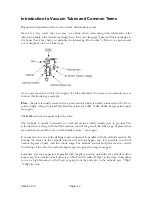
Version 3.2
Page: 13
In these amps, there are two volume
controls each controlling one stage of a
12AY7 tube. They are very simple and
economical circuits, only 5 parts per circuit.
Each output comes from the volume
control a
nd passes through an “isolation”
resistor
–
a resistor placed in the circuit to
isolate the two volumes from each other,
and at the same time to mix them for the
next single input tube stage.
The “feature” is that the isolation resistors
values (270K) do not isolate the stages
from each other enough
–
one stage can
still “see” the grid load resistance from the
other. It appears to the channel you are
plugged into, that there is another resistor
in the circuit formed by the other unused
volume control and its isolation resistor.
The real “magic” of it all is probably one of the absolute best “lessons” you can learn about
vacuum tubes. You would guess that the best and loudest tone would be with the highest
resistance, with the unused pot turned all the way
up, but that isn’t so. It is somewhere near
5 or 6 (on old amps, a new amp may have different pot tapers and it could appear at
different points.)
When you are turning the unused volume control you are “fine tuning” the grid load resistor
to the next stage of the amp. An optimum (best sounding) value is not all the way up, but
somewhere near the middle
–
the lesson? Tubes are NOT linear or mathematical devices
–
they do not respond to exact mathematical figures and have “hills and valleys” in their
response
–
maximum performance can not be calculated directly
–
you have to hear it and
you have to be aware that the “truth” may not be at some exact calculated place, but at
some far more imprecise figure.
The Tweed Deluxe is unique
in that the volume controls are not voltage dividers and
work by loading down the signal from the plates of the pre-amp tube. Because of this, you
get the maximum mids in the channel you are plugged into when the other volume control
is at it's mid position.. Max midrange scoop occurs when the other control is turned to full.
Set one channel (say Normal one) to max and the other (Bright) to mid position. When you
select the Bright channel, you should get nice clean tones and when you select the Normal
channel, you will get nicely distorted tones.
The clean tones work because you are not overdriving the bright channel and you are
scooping the midrange. On the Normal channel, you get the nice lead tones because you are
overdriving the output stage and boosting the mids.
Summary of Contents for Trinity Tweed Amp
Page 2: ...Version 3 2 Page 2 ...
Page 16: ......
Page 20: ...Version 3 2 Page 20 Input Jack Theory from 18watt com ...
Page 25: ...Version 3 2 Page 25 ...
Page 49: ...Version 3 2 Page 49 ...
Page 65: ...Version 3 2 Page 65 HEYBOER OT for TWEED 6L6GT CONVERSION ...
Page 66: ...Version 3 2 Page 66 ...
Page 75: ...Version 3 2 Page 75 ...
Page 76: ...Version 3 2 Page 76 ...
Page 77: ...Version 3 2 Page 77 Trinity Amps Schematics and Layouts ...














































